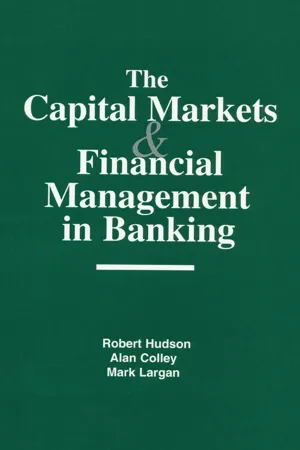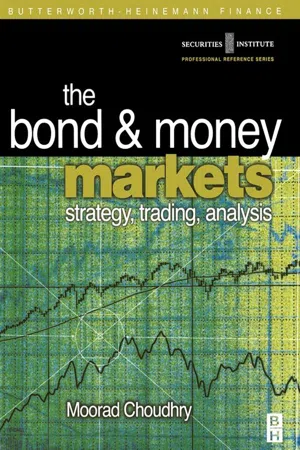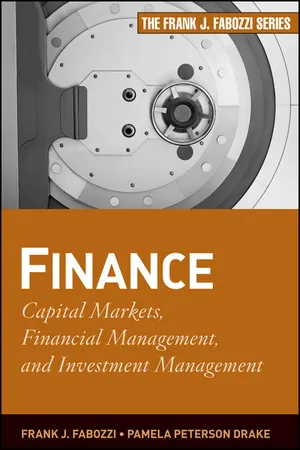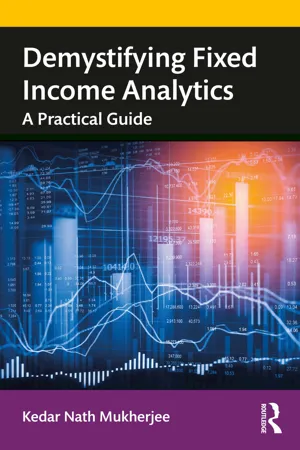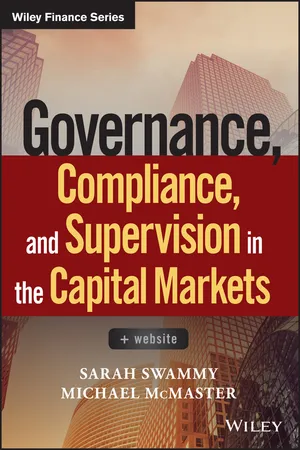Economics
Debt Capital Markets
Debt capital markets refer to the financial markets where companies and governments raise funds by issuing debt securities to investors. These securities, such as bonds and commercial paper, represent a form of borrowing for the issuer and provide a means for investors to earn fixed income. Debt capital markets play a crucial role in facilitating the flow of capital and liquidity in the economy.
Written by Perlego with AI-assistance
Related key terms
10 Key excerpts on "Debt Capital Markets"
- eBook - ePub
Finance in Asia
Institutions, Regulation and Policy
- Qiao Liu, Paul Lejot, Douglas W. Arner(Authors)
- 2013(Publication Date)
- Routledge(Publisher)
8 Debt securities, derivatives and complex transactions
Many people begin their day seeing or hearing overnight news through television, radio or the web. Whenever finance is mentioned the narrative will focus on home or foreign stock markets: ‘How did the Dow close?’; ‘Where is the Nikkei?’ Equity markets and prominent share prices form the universe of finance for many observers, at least outside personal concerns of consumer credit, pensions or bank deposits. Chapter 9 deals with this area of popular attention. Here we look at markets and instruments that are mysteries to many outside the financial sector, despite being subtly influential in their lives to a greater extent than equities or stock markets, and explain the operation of generic examples of these important transactions.Almost every topic in this book is determined or influenced by the behaviour of Debt Capital Markets. Tradable debt is central to all modern economies, regardless of their strain of capitalism, by virtue of facilitating markets in interest rates and credit risk. Capital allocation tends to be poorer when those price signals are unreliable, as in several Asian economies where interest rates are centrally managed or bond trading is curtailed. Well-functioning debt markets provide a price indicator for all financial and economic activities. They sit squarely at the heart of our book for these mechanical reasons and because they influence commercial conduct in more qualitative ways. States that lose the confidence of debt markets and investors will be pressured to adjust their economic policies, as Greece and Ireland found in 2010–11. These are only recent examples of the many sovereign debtors with similar experiences. Defaults or restructurings of domestic or external debt are far from uncommon, both historically and in the modern financialized era since 1970. The result are summarized in Box 8.1 - Robert Hudson, Alan Colley, Mark Largan(Authors)
- 2013(Publication Date)
- Routledge(Publisher)
11 Eurobonds and International Capital Debt Markets
A bond is a debt instrument issued in bearer or registered form. It constitutes a commitment by the issuer:- to pay a specified sum or sums of money to the holder at a predetermined date or dates;
- to pay interest to the holder at stated intervals either at a fixed rate agreed at the outset or on a floating rate basis often at a margin over a given benchmark, i.e. Libor or an agreed index, e.g. the FTSE index or gold.
The international debt markets are often thought of in terms of eurobonds only. Whilst the eurobond sector is the most visible, it is only one of the methods of capital finance and only one of the options for investors and there are many active domestic markets. Banks regularly access these markets to raise capital and are also active in them as lead managers, advisers, traders, market makers and investors.Domestic debt issues
A domestic debt issue is one that an issuer raises within its own country and is denominated in its own country’s currency. For example, an American company raising U.S. dollars in New York is a totally domestic issue. Domestic issues invariably have a greater attraction to investors resident in the country of issue than investors from elsewhere since most domestic securities are subject to withholding tax. Foreign investors may not be willing or able to take advantage of double taxation agreements which may exist between their own and the issuer’s country, for example, because of the delay in reimbursement of the amount withheld. Domestic issues, therefore, are usually placed mainly with investors of the issuer’s country.The largest and most developed domestic market is in the United States. It is expected that the European bond markets will expand considerably following EMU and in time may equal the U.S. markets in terms of size, trading volume, liquidity and innovation. Investors will have a far bigger domestic market, whereas before they were likely to be restricted to their own national market. A shift is taking place in these markets from government to corporate issues, which mirrors the U.S. markets.- Maureen Burton, Reynold F. Nesiba, Bruce Brown(Authors)
- 2015(Publication Date)
- Routledge(Publisher)
Part 4 Financial Markets- The Money Markets
- The Corporate and Government Bond Markets
- The Stock Market
- The Mortgage Market
Passage contains an image
Chapter Eleven 11 The Money Markets
DOI: 10.4324/9781315706405-15The need for a money market arises because receipts of economic units do not coincide with their expenditures. —Timothy Q. Cook and Robert K. LaRocheLearning Objectives
After reading this chapter, you should know:- What the money market is and how it is used by various participants
- Recent trends in money market instruments
- How the money markets have become international in scope
- What money market mutual funds are and why they have become important intermediaries
Financial Markets
In Part 4 of this text, we examine debt and equity markets more closely. The next three chapters look at the various capital markets, where financial assets with a maturity of greater than one year (or no maturity at all) are traded. Capital markets include the bond, stock, and mortgage markets and we spend a chapter discussing each one. In this chapter, we look at the money market—the short-term credit market where debt securities having original maturities of one year or less are traded. This definition distinguishes the money market from the capital market for longer-term debt and equity transactions. We begin by exploring how various participants use money market instruments to meet their borrowing and lending needs. In the second section, we review the individual money market instruments (originally covered in Chapter 3 ) and the development of money market mutual funds (MMMFs).- Moorad Choudhry(Author)
- 2001(Publication Date)
- Butterworth-Heinemann(Publisher)
1The Debt Capital Markets
Readers will be familiar with the cursory slot on evening television news, where the newscaster informs viewers where the main stock market index closed that day and where key foreign exchange rates closed at. In the United States most bulletins go one better and also tell us at what yield the Treasury long bond closed at. This is because bond prices are affected directly by economic and political events, and yield levels on certain government bonds are fundamental indicators of the economy. The yield level on the US Treasury long bond reflects the market’s view on US interest rates, inflation, public sector debt and economic growth. Reporting the bond yield level reflects the importance of the bond market to a country’s economy, as important as the level of the equity stock market.Bond and shares form part of the capital markets . Shares are equity capital while bonds are debt capital. So bonds are a form of debt, much like how a bank loan is a form of debt. Unlike bank loans however bonds can be traded in a market. A bond is a debt capital market instrument issued by a borrower, who is then required to repay to the lender/investor the amount borrowed plus interest, over a specified period of time. Bonds are also known as fixed income instruments, or fixed interest instruments in the sterling markets. Usually bonds are considered to be those debt securities with terms to maturity of over one year. Debt issued with a maturity of less than one year is considered to be money market debt. There are many different types of bonds that can be issued. The most common bond is the conventional (or plain vanilla or bullet ) bond. This is a bond paying regular (annual or semi-annual) interest at a fixed rate over a fixed period to maturity or redemption, with the return of principal- eBook - ePub
Corporate Finance
Theory and Practice
- Pierre Vernimmen, Pascal Quiry, Yann Le Fur(Authors)
- 2022(Publication Date)
- Wiley(Publisher)
market-based economy, companies cover most of their financing needs by issuing financial securities (shares, bonds, commercial paper, etc.) directly to investors. A capital market economy is characterised by direct solicitation of investors' funds. Economic agents with surplus resources invest a large portion of their funds directly in the capital markets by buying companies' shares, bonds, commercial paper or other short-term negotiable debt. They do this either directly or through mutual funds. Intermediation gives way to the brokerage function, and the business model of financial institutions evolves towards the placement of companies' securities directly with investors.In this economic model, bank loans are extended primarily to households in the form of consumer credit, mortgage loans, etc., as well as to small enterprises that do not have access to the capital markets.The following graphs provide the best illustration of the rising importance of capital markets.…be it in terms of the number of listed companies…Note: Domestic companies only.Source: Data from World Federation of Exchanges, NYSE-Euronext, London Stock Exchange, Bourse de Casablanca, Bolsa Madrid, Beirut Stock Exchange, Borsa Italiana…or market capitalisationSource: Data from World Federation of Exchanges, NYSE-Euronext, Beirut Stock exchange, Borsa Italiana, London Stock ExchangeTransaction volumes are linked to the economic environment, even if the long-term trend shows a clear increase.Source: Data from World Federation of Exchanges, SIFMASection 15.2 PRIMARY, SECONDARY AND DERIVATIVE MARKETS
1/ FROM THE PRIMARY MARKET TO THE SECONDARY MARKET
The new issues market (i.e. creation of securities) is called the primary market. Subsequent transactions involving these securities take place on the secondary market. Both markets, like any market, are defined by two basic elements: the product (the security) and the price (its value).Thus, shares issued or created when a company is founded can later be floated on a stock exchange, just as long-term bonds may be used by speculators for short-term strategies. The life of a financial security is intimately connected with the fact that it can be bought or sold at any moment. - eBook - ePub
Finance
Capital Markets, Financial Management, and Investment Management
- Frank J. Fabozzi, Pamela Peterson Drake(Authors)
- 2009(Publication Date)
- Wiley(Publisher)
money market funds and have restrictions as to what they can invest under U.S. securities law. Preferred stock would qualify if certain conditions are satisfied.Capital Market
The capital market is the sector of the financial market where long-term financial instruments issued by corporations and governments trade. Here “long-term” refers to a financial instrument with an original maturity greater than one year and perpetual securities (those with no maturity). There are two types of capital market securities: those that represent shares of ownership interest, also called equity, issued by corporations, and those that represent indebtedness, issued by corporations and by the U.S., state, and local governments.Earlier we described the distinction between equity and debt instruments. Equity includes common stock and preferred stock. Because common stock represents ownership of the corporation, and because the corporation has a perpetual life, common stock is a perpetual security; it has no maturity. In later chapters we describe common stock in more depth. Preferred stock also represents ownership interest in a corporation and can either have a redemption date or be perpetual.A capital market debt obligation is a financial instrument whereby the borrower promises to repay the maturity value one year after issuance. These debt obligations can be broken into two categories: bank loans and debt securities. While at one time, bank loans were not considered capital market instruments, in recent years a market for the buying and selling of these debt obligations has developed. One form of bank loan that is bought and sold in the market is a syndicated bank loan. This is a loan in which a group (or syndicate) of banks provides funds to the borrower. The need for a group of banks arises because the amount sought by a borrower may be too large for any one bank to be exposed to the credit risk of that borrower.Debt securities include (1) bonds, (2) notes, (3) medium-term notes, and (4) asset-backed securities. The distinction between a bond and a note has to do with the number of years until the obligation matures when the security is originally issued. Historically, a note is a debt security with a maturity at issuance of 10 years or less; a bond is a debt security with a maturity greater than10 years.8 - eBook - ePub
Demystifying Fixed Income Analytics
A Practical Guide
- Kedar Nath Mukherjee(Author)
- 2020(Publication Date)
- Routledge India(Publisher)
1 Fixed income securities are issued by various organizations, i.e. central and state governments, public bodies, statutory corporations, banks, financial institutions, and corporate bodies. These markets are an important source of funds, especially in developing economies like India. In order to finance its fiscal deficit, the government (central and state) borrows money from the market by issuing government securities (G-Secs.), which are sovereign securities issued by, say, the central bank of the country (e.g. Reserve Bank of India or RBI) on behalf of the government. The role of fixed income markets as an efficient tool to raise money for government projects (national and local) has been considered and appreciated worldwide for centuries.Global debt markets — a reviewThe financial market of an economy gets the status of developed market if it is characterized by proper financial, legal, and regulatory frameworks. Even if the equity markets of the financial system in most of the world economies, including India, are well developed, the same may not be valid in case of the bond market, especially the market for non-government securities. The following section deals with a broader overview of the debt market (government and non-government) in some of the developed and emerging, especially Asian, economies which have experienced a significant growth over the years in developing their debt (government and corporate) market.US debt marketThe bond market in the United States is the largest market in the world, with a total outstanding of USD 37.0 trillion at the end of 2017. The proportion of debt securities in the US securities market is almost equal to that of equities, reflecting an equal importance of their debt market (162% and 198% respectively for equities and debts as a percentage share of US GDP during the end of 2017) comparative to other economies, where concentration of equities is more than the debts. The corporate bond market in United States is again the largest market (22% of the total bond issuance in US) in the world, not only in terms of outstanding volume (USD 9 trillion during the end of 2017), but also in terms of annual turnover in the secondary market. The US debt market is a very well-developed and efficient market with a high level of liquidity in the secondary markets (USD 764 billion of daily trading volume, of which USD 505 billion was in Treasury securities during 2017). The reason for this being that the interest of not only the corporate but also the banks and other institutions tapping the debt market, rather than seeking loans or deposits to meet their financial requirements (10% of loan financing vs. almost of 70% of financing through capital markets). The US bond market is also well diversified and consists of several instruments, such as Treasury bills and bonds, federal agency securities, municipal bonds, corporate bonds, mortgage backed securities (MBS), asset backed securities (ABS), etc. In order to strengthen the demand for corporate bonds, a developed market like the US has experienced a significant demand from financial institutions like banks, mutual funds, insurance companies and pension funds. The US corporate bond market has experienced a wider investor base that also includes retail investors. Mortgage-related debt captures the maximum market share (annual average: 26–27%), followed by the Treasury issues and corporate debts, respectively, with an annual average of close to 24 and 20%. Domestic and foreign investors play a dominant role in the world’s largest debt market. The annual average participation of FIIs in the US Treasury market is almost 38.50% out of total outstanding Treasury debts. But in terms of average daily trading volume in US debt market, the Treasury market captures more than 60% of the secondary market trading, followed by the MBS (28%), and others. The development and growth in the US debt securities market are presented in the following tables (Table 1.1 to 1.3 - Sarah Swammy, Michael McMaster(Authors)
- 2018(Publication Date)
- Wiley(Publisher)
CHAPTER 1 Capital Markets Participants, Products, and FunctionsThis chapter provides an introduction to the participants, products, and functions of capital. We also discuss the important role capital markets play in supporting economic growth and development (Figure 1.1 ). We start with a detailed discussion of key participants and how capital markets support their economic activities. We then introduce the foundational product groups offered and review their key features and uses. Then we will explain the various types of markets and how they facilitate the funding and investing needs of participants.Capital markets environment.FIGURE 1.1THE BASIC PRODUCTS OFFERED IN CAPITAL MARKETS
For the focus of our discussion we view capital markets as offering two types of funding products to issuers: Equities and debt (also called fixed income) through both primary (initial issuance of securities) and secondary (ongoing trading of securities) markets. From a broader perspective, capital markets may also include the trading commodities, currencies, and derivatives.Equities
Equities, also known as shares and stocks, represent an ownership interest in a corporation; the term share means each security is a share of ownership in a corporation. Shares have the same limited‐liability rights of the corporations they represent, which means that the liability of share owners is limited to their investment amount. Shares are initially created when a corporation is formed, whereby the owners can choose the number of shares appropriate for the corporation's plans and valuation. At this point the corporation is known as a private corporation, as all the shares are held by a close group of investors.As corporations grow, some may choose to become a public corporation, or one that is listed on a public stock exchange, where members of the public can openly buy or sell shares. This process is known as listing where existing or additional shares may be created and offered to the public through an initial public offering (IPO).- eBook - ePub
- Michael Dempsey(Author)
- 2017(Publication Date)
- WSPC (EUROPE)(Publisher)
By lowering its own interest rate, the central bank induces the banks to reduce their level of cash with the central bank and instead lend it in the money markets, thereby adding to the money supply with a consequent lowering of prevailing interest rates. Thus, the rate that the central bank is prepared to pay on its accounts with the banks effectively determines the rate at which banks will lend to each other — on the basis that it represents the opportunity cost of a bank’s lending to another bank. The rate at which banks then charge each other for lending is termed the prime rate and represents a base rate from which a range of interest rates are referenced. 4.4 Long-term debt The debt for a company can be long-term or short-term, secured or unsecured, convertible or not convertible into ordinary shares, and so on. The term “long-term debt” refers to debt instruments with maturities greater than one year. When a company or (individual) borrows from a bank or a building society with the understanding that the loan arrangement will continue to exist between the company (or individual borrower) and the lending bank or building society for the duration of the loan, we have what we may refer to as private debt. In this case, the loan can be structured on a one-to-one basis between the borrower and the lending institution to suit individual needs. For example, the interest rate may be fixed for the duration or allowed to be variable in connection with prevailing interest rates as they change through time. A traditional mortgage on a house, whereby the household’s repayments continue to be made to the bank or mortgage company, is an example of private debt. 3 Corporate bonds are issued by corporations or companies seeking to raise long-term financing by borrowing. In contrast with private debt, the bond is designed as a security. This means that, unlike private debt, the bond can be sold on in the market place - eBook - ePub
The Capital Markets
Evolution of the Financial Ecosystem
- Gary Strumeyer(Author)
- 2017(Publication Date)
- Wiley(Publisher)
CHAPTER 8 Money Markets Randy Harrison and Paul MandelMuch of the U.S. economy relies on the scale and efficiency of the money markets. This is one of the most important financial markets that keeps our U.S. government, our local governments, and agencies, corporations, banks, other financial institutions, and broker‐dealers functioning smoothly for the benefit of its stakeholders and clients. The U.S. money markets include capital markets debt instruments with maturities of one year and less. Enormous cash flows are transacted daily in money market products that are readily accepted by investors due to the money market's liquidity, short duration, and strong credit quality. The Federal Reserve Bank is a significant strategic participant in the U.S. money markets and through its actions implements interest rate policies that impact the broader capital markets, including the bond and stock markets as well as the foreign exchange market. The principal purpose of the money markets from an issuer's perspective is to enable the federal government and domestic corporations to fund their short‐term cash needs, principally working capital. Investors who seek short‐term investment securities known for high credit quality that typically can be quickly converted to cash look to the money markets. This chapter will focus on the most significant instruments that comprise the U.S. money markets: fed funds, repurchase agreements, Treasury bills, agency securities, commercial paper, certificates of deposit, Eurodollar deposits, short‐dated municipal notes, and variable‐rate demand notes.The end of this chapter will examine the impact of money market products during the Global Financial Crisis of 2007 and 2008. This financial crisis permanently altered the money markets in many ways. In the wake of the crisis, sweeping changes were made to regulations governing money market funds as well as to rules dictating how banks fund themselves. Prior to the financial crisis, there were several products, such as structured investment vehicles and auction rate securities
Index pages curate the most relevant extracts from our library of academic textbooks. They’ve been created using an in-house natural language model (NLM), each adding context and meaning to key research topics.

